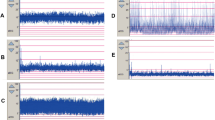Abstract
We have studied 20 comatose intensive care patients with head injuries and/or intracranial, haemorrhage in order to compare two different monitoring methods of the central nervous system. The level of unconsciousness was followed on the Glasgow Coma Scale (GCS). EEG was monitored continuously with the compressed spectral array (CSA)-method. CSA findings were classified into six categories according to the frequency content, reactivity and the amount of isoelectricity. The patients were divided into four groups according to the outcome: well-recovered, moderately recovered, poorly recovered and dead. The prognostic value of the data obtained with the GCS method was compared with that obtained by CSA.
The CSA and GCS methods give information based on different neurophysiological backgrounds. This explains why the correlation of these methods was only moderate. When combining the information received from these two methods the predictability improved. In many acute situations CSA gave information about changes in the brain function, which could not be seen in GCS. The results suggest that CSA is not only a supplementary method to GCS but also a different approach to the monitoring of an unconscious patient.
Similar content being viewed by others
References
Alexandre A, Colombo F, Nertempi P, Benedetti A: Cognitive outcome and early indices of severity of head injury. J Neurosurg 59: 751–761, 1980.
Bickford RG, Billinger TW, Fleming NI, Stewart L: The compressed spectral array (CSA)—a pictorial EEG. Proceedings of the San Diego Biomedical Symposium 11: 365–370, 1972.
Braakman R, Habbema JDF, Gelbke GJ: Prognosis and prediction of outcome in comatose head injured patients. Acta Neurochir, Suppl 36: 112–117, 1986.
Bricolo A, Turazzi S, Faccioli F, Odorizzi F, Sciaretta G, Erculiani P: Clinical application of compressed spectral array in long-term EEG monitoring of coma patients. Electroenceph Clin Neurophysiol 45: 211–225, 1978.
Cant BR, Shaw NA: Electroencephalography and compressed spectral array in severe intracranial disease. Int Anesthesiol Clin 17: 343–374, 1979.
Cant BR, Shaw NA: Monitoring by compressed spectral in prolonged coma. Neurol (Cleveland) 34: 35–39, 1984.
Harner R, Naquet R (eds) Altered states of consciousness, coma and cerebral death. In: Handbook of electroencephalography and clinical neurophysiology, Remond A (ed) Amsterdam: Elsevier Co. 12: 1–161, 1975.
Karnaze DS, Marshal LF, Bickford RG: EEG monitoring of clinical coma: The compressed spectral array. Neurol (NY) 32: 289–292, 1982
Plum F, Posner JB: The Diagnosis of Stupor and Coma. F.A. Davis Co, Philadelphia 1980
Teasdale G, Jennet B: Assessment of coma and impaired consciousness. Lancet II: 81–84, 1974.
Starmark JE, Lindgren S: Is it possible to define a general ‘conscious level’? Acta Neurochir, Suppl 36: 103–105, 1986.
Author information
Authors and Affiliations
Rights and permissions
About this article
Cite this article
Häkkinen, V.K., Kaukinen, S. & Heikkilä, H. The correlation of EEG compressed spectral array to Glasgow coma scale in traumatic coma patients. J Clin Monit Comput 5, 97–101 (1988). https://doi.org/10.1007/BF02919650
Accepted:
Issue Date:
DOI: https://doi.org/10.1007/BF02919650




